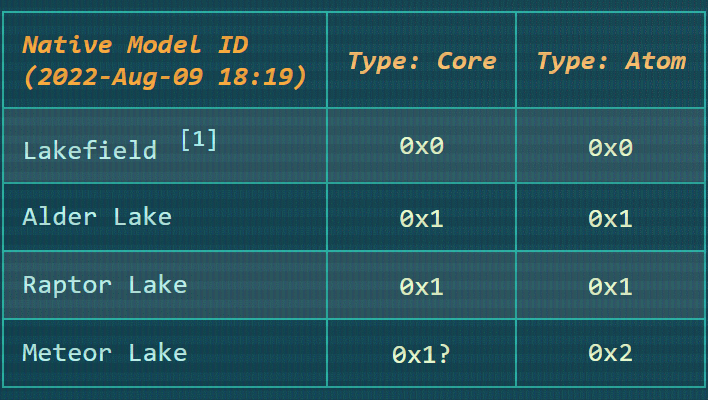Intel Meteor Lake 14th Gen Will Bring Big Architectural Changes For Efficiency Cores

Let's step back for a second. The codename for Intel's extant Core processors is "Alder Lake", or "ADL" in short form. Its upcoming 13th-gen processors are known as "Raptor Lake" (RPL), and their chiplet-based successors will be the 14th-gen "Meteor Lake" (MTL) processors.

What is a bit surprising is the detail that Japanese hardware blog Coelacanth's Dream has pointed out from the logs. In these files, the identifiers used to specify the core architectures used for Performance and Efficiency cores in these hybrid processors are different from the standard CPUID identifiers. They're known as "Native Model IDs," and they start from zero with Lakefield's Sunny Cove and Tremont cores.
Meanwhile, Raptor Lake is known to carry forward the Gracemont design from Alder Lake, but it seems like the Crestmont E-cores in Meteor Lake will be a significant revision. That's based on the fact that the first increment of either Native Model ID since Alder Lake will be for Crestmont. Unfortunately, this information doesn't actually tell us anything about what will be changed in Crestmont.
Arguably the more interesting news is that Redwood Cove could be another revision of the Golden Cove architecture. Way back in May, leaker Raichu (@OneRaichu on Twitter) noted that Redwood Cove will focus on efficiency improvements at every level, including the core architecture. This is likely because the Intel 4 process that Meteor Lake will be using can't reach the same insane clock rates that Intel's mature "Intel 7" process can. More recently, fellow leakers @harukaze5719 and @9550pro had the same discussion after the Coelacanth's post above.
As a result, it seems like Meteor Lake may not offer much improvement in performance over Raptor Lake, at least for high-powered desktop processors. However, the performance-per-clock should be improved considerably, which means power-limited platforms like laptops should see huge gains.
For his part, Raichu says that Golden Cove in its current form has significant inefficiencies with regard to instruction execution, and that it isn't performing to its full potential. Perhaps changes with Raptor Cove and Redwood Cove will unlock the full speed of the core architecture.




